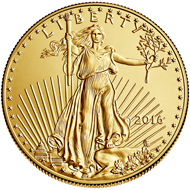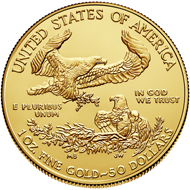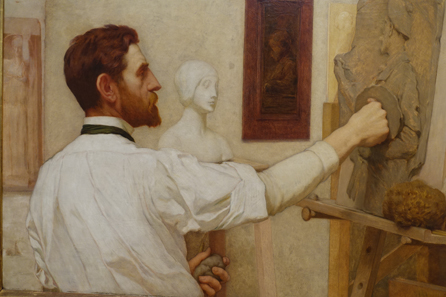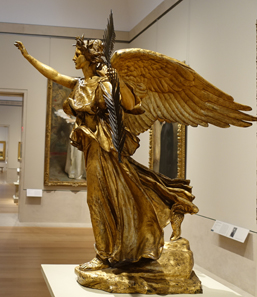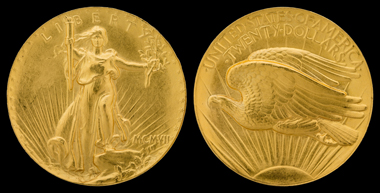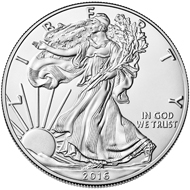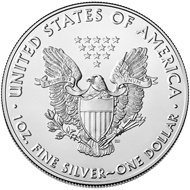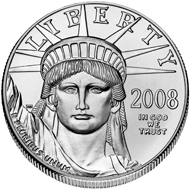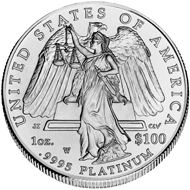translated by Christina Schlögl
The American Eagle has existed since 1986. In the year before, 1985, Congress had authorized the US Mint to release the gold bullion coin. Traditionally, it is minted with gold from the US. The alloy consists of 22 carat gold (= 91.66%), 5.33% copper and 3% silver. The material is thus slightly darker than that of other bullion coins and it has a higher hardness, making it less susceptible to scratches.
The American Eagle in gold has been issued since 1986. Photo: US Mint.
Congress already decided how the coin should look in the law passed in 1985 – today it only differs in one aspect. While up until 1991, the minting date was written in Roman numerals, it was changed to Arabic numbers in 1992.
Kenyon Cox (1856-1919) Augustus Saint-Gaudens, oil painting 1908, Metropolitan Museum of Art / Photo: Ursula Kampmann.
The most beautiful coin of America: The obverse of the American Eagle
In 1905, President Theodore Roosevelt (president 1901-1909) received a famous guest for a small, informal lunch. Augustus Saint-Gaudens (1848-1907) was one of the most important American sculptors at the time. He was known as a representative of the American Renaissance. He had already learnt how to cut gems at age 13 and was thus an ideal contact for Theodore Roosevelt to address a problem of national importance. The President simply abhorred the American coins. Wasn’t there something, Saint-Gaudens could do?
Victoria, impression of a figure of the memorial for William Tecumseh Sherman by Augustus Saint-Gaudens. Metropolitan Museum of Art / Photo: Ursula Kampmann.
Saint-Gaudens hesitated. He was suffering from cancer and had retreated to Cornish in New Hampshire several years ago. He wanted to stay away from trouble. And working with the American mint would be trouble. He knew that, because the artist had already worked with them in the past. But Roosevelt was persistent. He would back Saint-Gaudens and give him enough space to realise his artistic concepts.
The 20 dollar coin, designed by Augustus Saint-Gaudens. Photo: National Numismatic Collection, National Museum of American History / Jaclyn Nash.
Saint-Gaudens vs. Charles Barber – or how a piece of art became suitable for the mass
Saint-Gaudens accepted. He developed a pencil sketch and several rough drafts in gesso, which his assistant Henry Hering finished, following Saint-Gaudens’ instructions. That took some doing, since every new step was heavily opposed by the mint. While Saint-Gaudens was trying to create a piece of art for all eternity, the main die cutter of the mint, Charles Barber demanded a coin suitable for mass production.
In February 1907, Saint-Gaudens was holding first samples in his hand. After putting in a lot of effort, they had reached their goal: the new coins were sculptures in miniature format. The president was overjoyed, but the workers of the mint were not. There was no way to mint coins in larger quantities using Saint-Gaudens’ designs, since they had to make huge efforts to mint them.
Saint-Gaudens spent the following half year, the last months of his life, working with his assistant to find a compromise in order to adjust the grandeur of the design to the needs of the toggle presses. In August 1907, the problem still was not solved, but Roosevelt insisted on minting a small emission of 12,000 coins. It turned out, that Charles Barber had been right. The design was completely unfit for mass production. There were up to 11 minting processes needed to achieve the high relief! Death decided on the fate of the effigy. After Saint-Gaudens had died, Charles Barber changed the effigy to make it suitable for circulation coins. He received a lot of insult and little appreciation for his pragmatic solution.
The monogram of Augustus Saint-Gaudens. Detail from Image 1.
Nonetheless, Augustus Saint-Gaudens’ monogram is still on the coins. That includes the Golden Eagle, whose obverse subject was modelled after the old 20$ coins.
The bald eagle. Photo: Dave Menke / United States Fish and Wildlife Service.
The ideal American family – the reverse
The official statement of the US Mint says that the reverse’s subject of the Golden Eagle symbolizes the traditional American value of family. The coin shows the nest of the heraldic animal of the United States, the American eagle. One of the two adult birds is sitting in the nest and protects two young birds with his right wing. A second eagle is approaching from the left. This lovely family idyll, in which one part (are we safe to assume it is the female?) takes care of the house and children, while the other one goes away to provide for the family, is supposed to symbolise American family tradition and unity.
The American eagle, the heraldic animal of the Unites States, is actually a bald eagle or white-headed eagle (haliaeetus leucocephalus). With their body length of 70-90 cm and their wingspan of 1.80-2.30 m, they are the biggest accipitrids in North America. Originally, these magnificent predator birds could be found all over North America. Due to environmental influence though, their stocks concentrate to the coastal regions and Alaska – and some bigger populations in Canada.
The USA has directed major efforts to saving their heraldic animal from extinction. The bald eagle was actually taken off the U.S. federal government’s list of endangered species and reclassified from “endangered” to “threatened” on 12 July 1995. It was completely de-listed on 28 June 2008.
The collector’s edition of the Eagle differs by mint mark. W for West Point. Photo: US Mint.
Numismatic variants
The US Mint issues an additional, uncirculated collector’s version proof coin of the American Golden Eagle. It has the mint mark “W” for West Point for distinction.
The American Silver Eagle. Photo: US Mint.
Metal variants of the Eagle
Since 1986, the Silver Eagle has only ever been available in 1 ounce weight with the denomination of one dollar. Its obverse is modelled after a sketch of Adolph A. Weinman from 1916. Its reverse shows the heraldic eagle, as seen on the 1$ bill.
The American Platinum Eagle. Photo: US Mint.
Furthermore, the Platinum Eagle has been issued since 1997 with changing reverses. There are: a one ounce platinum coin with a denomination of $100, a 1/2 ounce worth $50, a 1/4 ounce worth $25 and a 1/10 ounce worth $10.
The American Eagle in gold has been issued since 1986. Photo: US Mint.
Numismatic Data of the American Eagle
Coin description:
Obverse: LIBERTY Female personification of liberty with windblown hair walking head-on, holding a torch in her right hand and a laurel branch in her left hand; her right foot on a rock, in front of it oak leaves, above it the monogram of the artist August Saint-Gaudens, the Capitol left in the background; all of it surrounded by the glory of the rising sun.
Reverse: UNITED STATES OF AMERICA Eagle sitting in its nest, shielding two young eagles with its right wing; another eagle approaching left, bearing a branch in its claws, whose design strongly resembles that of the laurel branch; left E PLURIBUS UNUM (= From Many, One), right IN GOD WE TRUST; below denomination.
US-Dollar 50 / 1 ounce / 916.66 / 33.93 g (31.103 g) / 32.70 mm / 2.87 mm
US-Dollar 25 /1/2 ounce / 916.66 / 16.97 g (15.552 g) / 27 mm / 2.24 mm
US-Dollar 10 / 1/4 ounce / 916.66 / 8.48 g (7.776 g) / 22 mm / 1.83 mm
US-Dollar 5 / 1/10 ounce / 916.66 / 3.39 g (3.110 g) / 16.5 mm / 1.19 mm
Here you will find the United States Mint.
You can find two films about this topic at CoinsWeekly.
This link will take you to a film about Saint-Gaudens and his sketch for a new circulation coin for the USA.
And this film will tell you about the secret message, hidden in every dollar.
All episodes of the bullion coins series are available here.




